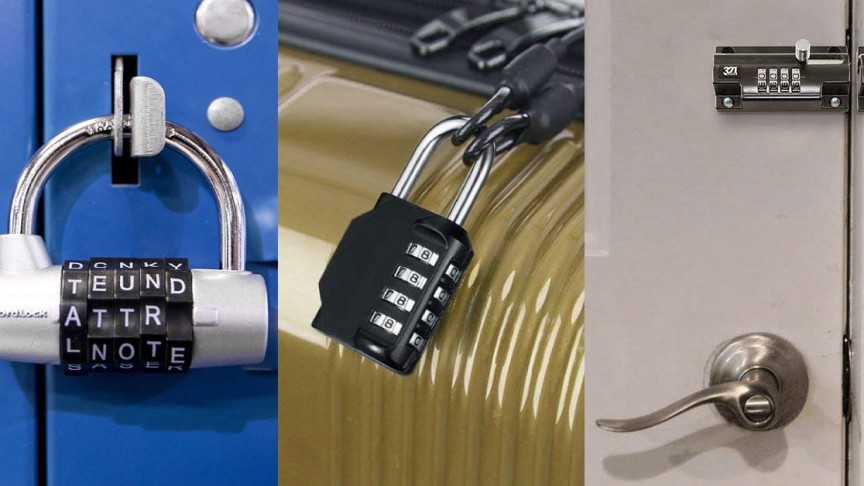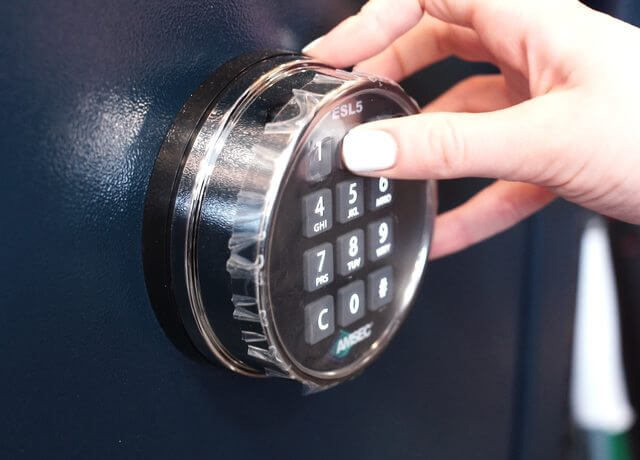Combination Locks
A combination lock is a type of padlock in which a sequence of numbers or symbols is used to open the lock. The sequence may be entered using a single rotating dial which interacts with several discs or cams, by using a set of several rotating discs with inscribed numerals which directly interact with the locking mechanism, or through an electronic or mechanical keypad. Types range from inexpensive three-digit luggage locks to high-security safes. Unlike a regular padlock, combination locks do not use keys.
The earliest known combination lock was excavated in a Roman period tomb on the Kerameikos, Athens. Attached to a small box, it featured several dials instead of keyholes.In 1206, the Muslim engineer Al-Jazari documented a combination lock in his book al-Ilm Wal-Amal al-Nafi Fi Sina’at al-Hiyal (The Book of Knowledge of Ingenious Mechanical Devices).Muhammad al-Astrulabi (ca. 1200) also made combination locks, two of which are kept in Copenhagen and Boston Museums.
Gerolamo Cardano later described a combination lock in the 16th century.
In 1878 a German man by the name of Joseph Loch was said to have invented the modern combination lock for Tiffany’s Jewelers in New York City, and from the 1870s to the early 1900s made many more improvements in the designs and functions of such locks.
Multiple-dial locks
One of the simplest types of a combination lock, often seen in low-security bicycle locks and in briefcases, uses several rotating discs with notches cut into them. The lock is secured by a pin with several teeth on it which hook into the rotating discs. When the notches in the discs align with the teeth on the pin, the lock can be opened.
This lock is considered to be one of the least secure types of combination lock; many locks of this type can be quickly opened without the knowledge of the correct combination. Opening one in this fashion depends on slight irregularities in the machining of the parts. Unless the lock is machined precisely, when the pin is pulled outward, one of the teeth will pull more strongly than the others on its corresponding disc. This disc is then rotated until a slight click is heard, indicating that the tooth has settled into the notch. The procedure is repeated for the remaining discs, resulting in an open lock, and a correct combination, in very little time.

Single-dial locks
Combination locks found on padlocks, Lockers, or safes may use a single dial that interacts with several parallel discs or cams. Customarily, a lock of this type is opened by rotating the dial clockwise to the first numeral, counterclockwise to the second, and so on in an alternating fashion until the last numeral is reached. The cams typically have an indentation or notch, and when the correct combination is entered, the notches align, allowing the latch to fit into them and open the lock.
Depending on the quality of the lock, some single-dial combination locks can also be defeated relatively easily. Typical padlocks are manufactured with generous tolerances, allowing two, three or even more digits of ‘play’ in the correct access sequence. Given a 60-number dial with three cams and three digits of play, the search space is reduced from 60 × 60 × 60 to 20 × 20 × 20, a 96% reduction in potential combinations.
Additionally, if testing the mechanism to open the lock does not modify the state of the lock, multiple combinations can be tried sequentially, drastically reducing the brute force search time. The first two digits are entered normally once, then, starting from the second digit, the dial is rotated sequentially through the digits, testing the lock on each. If it takes three seconds to input the first digit, two seconds for the second digit, and one second for the third digit, then the normal search time for a 60-number dial with three cams would be (3 + 2 + 1) × 60³. The reduced search time would be (3 + 2 + 60) × 60², a reduction of nearly 82% from 360 hours to 65 hours. This strategy can be extended to the second digit as well, slightly reducing the search time further.
When these two strategies are combined on a lock with the properties given above, the brute force search time is reduced by greater than 99%; a brute force search that would have taken 360 hours is reduced to an achievable 2.78 hours. This is still significantly better security than multiple-dial locks and many keyed locks, but unacceptable for high-security applications.
Inexpensive padlocks are often also susceptible to direct mechanical attacks, such as the use of a padlock shim which can release the shackle without entering a combination. Early combination padlocks made by Master Lock could be cracked by pulling on the shackle of the lock and turning the dial until it stopped; each numeral in the combination could be revealed in this manner. More recent models of Master padlock with a 40-position dial have a mechanical weakness that can give away the last numeral in the combination, and the first two numerals have a mathematical relationship with the last number. This weakness reduces the number of possible combinations from 64,000 to a mere 100, which can be tried in a very short time.

In 1978 a combination lock that could be set by the user to a sequence of his own choosing was invented by Andrew Elliot Rae. At this time the electronic keypad was invented and he was unable to get any manufacturers to back his mechanical lock for lockers, luggage, or brief-cases. The silicon chip locks never became popular due to the need for battery power to maintain their integrity. The patent expired and the original mechanical invention was instantly manufactured and sold worldwide mainly for luggage, lockers, and hotel safes. It is now a standard part of the luggage used by travelers.